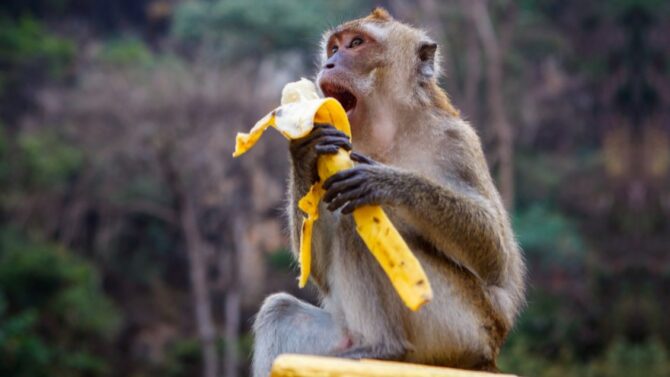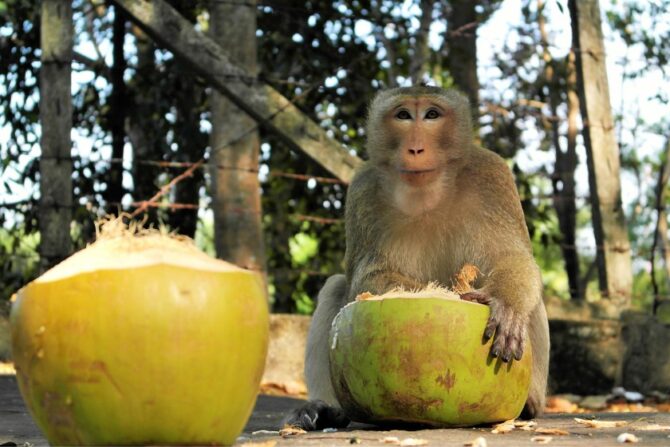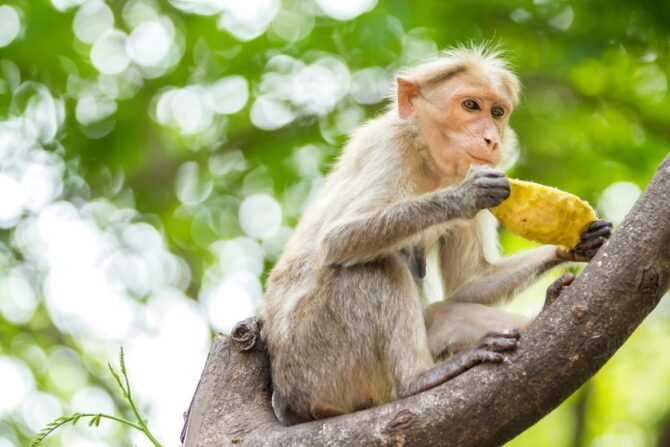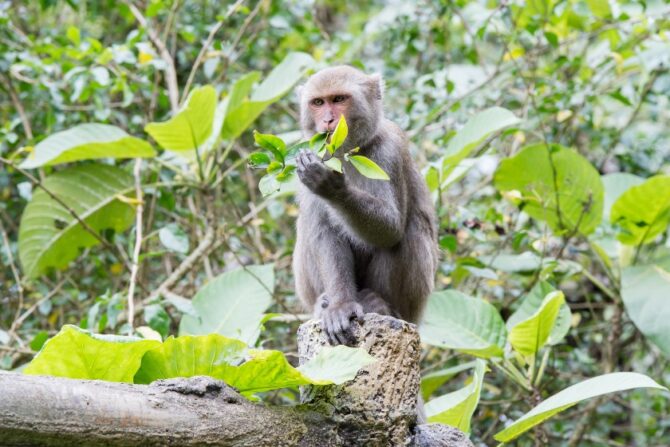
This stereotype has been made popular by movies, and now many consider these intelligent primates to be frugivores.
However, you’d be surprised to learn that monkeys in the jungle have a wider range of diets than what you’ve learned.
A lot of monkeys in the wild eat both plants and meat, making them omnivores. Even the herbivorous ones are not limited to fruits. There are no carnivorous monkeys, of course. The monkey’s diet includes nuts, seeds, and eggs.
Read on to learn more as we dive into the nutritional needs of monkeys.
Monkeys: An Overview
The term “monkey” is used to designate a wide range of primate species. They go from small animals like the thumb monkey to huge ones like the Grauer’s gorilla.
They are related to the apes, under which humans are also classified. Some apes—like the chimpanzee—are sometimes called monkeys.
There are some differences between monkeys and apes, though, one of which is that the former has tails.
Monkeys belong to the infraorder Simiformes, where apes are also classified (which explains the mixtures).
These animals can be found all over the world except Antarctica, and they are often a delight in zoos.
Monkeys share many humanlike characteristics, including laughing and making faces.1 They are known to be arboreal as well.
Some individuals are kept as pets, and others remain in the wild.
What Do Monkeys Eat?

Like humans, monkeys have a wide range of diets.
Baby monkeys rely mainly on breast milk gotten from the mother. This is common with mammals. As they get older, their dietary need changes, and they start to consume more solid food. These include:
- Nuts
- Fruits
- Seeds
- Eggs
- Insects
- Lizards and other small animals
While it may be hard to imagine a monkey eating meat, a lot of them do, especially if their environment is teeming with those.
They tend to adapt to what they can find around them. This can be either plants or meat.
Some monkey species are built to adapt to a particular diet. The howler monkey is a good example.
These species have a long digestive tract that helps absorb leaf nutrients. Thus, the howler monkey is primarily herbivorous.
Having established that the monkey’s diet goes beyond fruits, we should still point out that these animals seem to prefer fruits.
They are often found on trees reaching out for the closest fruit.
Are Monkeys Herbivores, Carnivores, or Omnivores?
Generally speaking, monkeys can be considered omnivores rather than herbivores as they feed both on plants and small animals.
In that sense, they are more like humans than cattle. However, when we compare the ratio of plants versus animals, monkeys seem to eat more plants than they do meat.
This might be because plants are readily accessible.
Some monkey species could be considered herbivores. An example is the vervet monkey. This old-world species from Africa feeds mainly on wild fruits, seeds, leaves, and seed pods.
However, even these species feed on animals when necessary. The vervet monkey can eat invertebrates.
Some monkeys, such as baboons and mandrills, may have a diet that is more herbivorous and includes a greater emphasis on plant matter, while other species, such as macaques and capuchins, may have a diet that is more omnivorous and includes a greater variety of both plant and animal matter.
Do Monkeys Eat Bananas?
So far, we’ve established that monkeys are omnivores that rely more on plants than animals.
This leads us to the common stereotype of monkeys eating bananas.
Pop culture has given us the impression that monkeys are banana fanatics, but is this true? Do monkeys eat bananas?
Monkeys in captivity are often fed bananas, which is possibly where the stereotype was birthed.
Monkeys in the wild, however, do not rely on bananas. They feed more on fruits like citrus and berries.
Also, monkeys don’t usually eat the same banana that we do. Our banana is a hybrid and is tastier than the one in the wild. Only some monkeys in captivity can eat those.
Where Do Monkeys Find Their Food?
Finding food isn’t rocket science for monkeys. They often make do with what is in their habitat, going for what gives them easy nutrients.
The latter includes fruit sugar, fiber, carbohydrates, and animal protein. One of their many assets is their thumb which helps them pluck at fruit and climb trees.
Monkeys that eat insects and other invertebrates often go hunting for them.
They find trees where their prey is in abundance and eat as much as they can.
They also do some travel in search of food if their current habitat doesn’t have it.
Another interesting fact is that some species have places to store their meal. They either keep it in their cheek pouch or store it in caches.
Which Food is Bad for Monkeys?
Surprisingly, some experts warn against feeding a monkey too many bananas, especially the hybrid ones.
Because hybrid bananas are too sweet, they can cause an increase in sugar, leading to diabetes.
Monkeys shouldn’t also eat human food, especially those created through fermentation, like yogurts, bread, and cheese.
This is why many zoos discourage feeding these animals. Human food can affect the gut health of the monkey.
Feeding a monkey also makes it dependent on humans, which will have an effect.
Other foods bad for monkeys include the devil’s trumpet and the angel’s trumpet.
New World Monkeys vs. Old World Monkeys Diets

New-world monkeys and old-world monkeys have some differences in their diet.
New world monkeys, which are native to South and Central America, tend to have a diet that is more omnivorous and includes a wider variety of fruits, flowers, and insects. Some examples include the capuchin, marmosets, tamarins, squirrel, and howler monkeys.
Old-world monkeys, which are native to Africa and Asia, tend to have a diet that is more herbivorous and includes a wider variety of leaves and grasses. Some examples are baboons, macaques, mandrills, bushbabies, and vervet monkeys.
However, both types of monkeys will also eat insects and other small animals, such as frogs, lizards, and snails, as a source of protein.2
It’s worth noting that there is a lot of variation within each group of monkeys, and the specific diet of a particular species will depend on its habitat and the availability of different types of food.
List of Foods Monkeys Eat
In the wild:
- Insects and other invertebrates
- Bananas, mangoes, and fleshly fruits
- Grass, leaves, seeds
- Flowers, gums, nectars
- Bird eggs, lizards, small birds, squirrels
In captivity:
- Fruits are given by their captors.
Do monkeys prefer plants, meat, or both?
Monkeys eat both animals and plants, but their preference is clearly to plant. Plants make up almost 90% of most species, with animals filling the remaining 10%. The predominance of plants over animals is what makes people think monkeys are herbivores or frugivores, but as we’ve seen, that’s not necessarily the case. Monkeys are omnivores.
Summary

Monkeys feed on a lot more than bananas, and though their diet consists more of plants, they are generally considered omnivores.
There is a lot of variation in the diet of different species of monkeys. This is because monkeys are found in a wide range of habitats, and the availability of different types of food can vary greatly depending on the local climate, vegetation, and other environmental factors.
Additionally, different species of monkeys have evolved different physical and behavioral adaptations that allow them to access and exploit different types of food.
For example, some species of monkeys are primarily herbivorous and rely on a diet of leaves, grasses, and other plant matter. Other species are more omnivorous and will eat a wider variety of foods, including fruits, seeds, nuts, insects, and small animals.
Some species of monkeys are adapted to eating a diet that is high in leaves, while others are adapted to eating a diet that is high in fruits.
Also, some types of monkeys are adapted to eating a diet that is high in insects, while others are adapted to eating a diet that is low in insects.


